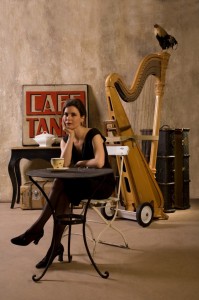 Tango has a local off-shoot in Turkey, like in Finland, going back to the middle of 20th century. Composers and singers have specialized in the local genre, quite popular in Mid-Century, and the fire never quite died out. Turkish tango developped as a direct influence of tango’s international rise in the first half of 20th century. Turkish radios played a lot of tango music and Atatürk, the founder of the Turkish Republic, loved tango. The famous “La Cumparsita” became “the first dance” at Turkish metropolitan weddings. Turkish lyrics were written to Argentinian tangos composers in Turkey started writing original tangos to lyrics in Turkish. During he last 15 years or so Istanbul is cited as the second most city to hold milongas in the world after Buenos Aires. Turkish tango is full of nostalgia and although it is more simple from a rhythmical point of view compared to its Argentinian version, it is nonetheless a very recognizable, rooted genre in Turkish musical culture.
Tango has a local off-shoot in Turkey, like in Finland, going back to the middle of 20th century. Composers and singers have specialized in the local genre, quite popular in Mid-Century, and the fire never quite died out. Turkish tango developped as a direct influence of tango’s international rise in the first half of 20th century. Turkish radios played a lot of tango music and Atatürk, the founder of the Turkish Republic, loved tango. The famous “La Cumparsita” became “the first dance” at Turkish metropolitan weddings. Turkish lyrics were written to Argentinian tangos composers in Turkey started writing original tangos to lyrics in Turkish. During he last 15 years or so Istanbul is cited as the second most city to hold milongas in the world after Buenos Aires. Turkish tango is full of nostalgia and although it is more simple from a rhythmical point of view compared to its Argentinian version, it is nonetheless a very recognizable, rooted genre in Turkish musical culture.

I have been a big fan of tango music for a long time. It goes back to the days when I was a student at Indiana University Jacobs School of Music. The school was home to the Latin American Music Center, an impressive archive represented by an amazingly knowledgeable staff. There, I came accross lots of recordings and scores and was very lucky to have expert guidance for appreciating and understanding tango music. But listening to tango alone would probably never spark me to create a stage project with it. It was the fiery professional shows I watched in New York and Washingon D.C. in the early 90’s of great Argentinian dancers which left an incredible sensation in me. It was also the single dance class I took with Nestor (Nestor Ray) who was actor Robert Duvall’s friend and tango teacher. After one of the shows I watched in Washington D.C., I met the couple who sat in the front row. They were from Latin America. After exchanging some words, they offered to take me to Nestor. We drove to Duvall’s Virginia farm where “Nestor” was teaching in the barn. Next thing I know, my feet were cut off from the ground and I was flying from one end of the barn floor to the other in Nestor’s arms! Only afterwards I would learn that I was very lucky for this occasion, as Nestor was the very famous teacher of Hollywood stars…
 But tango is more than music and more than dance for me. It is a partial embodiment of family history as well. My grandpa, whom I never met, is from the small Anatolian town of Develi. In the Ottoman period. Develi was home, like many other places in Turkey, to Anatolian Armenians and Greeks. Just about when the first world war broke and many Anatolians were displaced, Armenians and Greeks of Develi left for America. Grandpa, as a young man joined his friends and left his hometown probably in 1914. He embarked on a boat to “America” and landed in Buenos Aires with his younger brother. He worked and lived there for five years. Eventually, the two returned to Turkey as they became of age to marry. 80 years later, at a concert in Brazil, after I played a little tango, an old man with a top hat who was in the audience approched me and whispered in my ears that I had tango in my blood. He was from Argentina. I thought, how could tango be in my blood? Well, perhaps it could, if my grandpa was exposed to it.
But tango is more than music and more than dance for me. It is a partial embodiment of family history as well. My grandpa, whom I never met, is from the small Anatolian town of Develi. In the Ottoman period. Develi was home, like many other places in Turkey, to Anatolian Armenians and Greeks. Just about when the first world war broke and many Anatolians were displaced, Armenians and Greeks of Develi left for America. Grandpa, as a young man joined his friends and left his hometown probably in 1914. He embarked on a boat to “America” and landed in Buenos Aires with his younger brother. He worked and lived there for five years. Eventually, the two returned to Turkey as they became of age to marry. 80 years later, at a concert in Brazil, after I played a little tango, an old man with a top hat who was in the audience approched me and whispered in my ears that I had tango in my blood. He was from Argentina. I thought, how could tango be in my blood? Well, perhaps it could, if my grandpa was exposed to it.
My interest in tango music led me to mount a semi-staged tango performance entitled Cafe Tango which premiered in 2011. It involves a stage band, a singer, a mute actor and dancers. I made some of the arrangements, commissioned others that seemed out of my reach in the beginning, designed the set, assumed the musical direction and played the harp. The music featured was Argentinian and Turkish. As such, we performed a couple of sold out performances which seemed to hit a high point with audiences.

There was a need to make a recording; however, the royalties the copyright owners requested for the Turkish tangos (almost entirely under copyright) were astronomical and infeasible. So the recording featured Argentinian tangos along with new Turkish tangos that were stylistically embedded in the old tango flavour audiences are used to. The “Cafe Tango” CD was released on the Kalan label in 2015.












